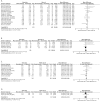Intake of Palm Olein and Lipid Status in Healthy Adults: A Meta-Analysis
- PMID: 31095284
- PMCID: PMC6628844
- DOI: 10.1093/advances/nmy122
Intake of Palm Olein and Lipid Status in Healthy Adults: A Meta-Analysis
Abstract
It is not clear whether a saturated fatty acid-rich palm olein diet has any significant adverse effect on established surrogate lipid markers of cardiovascular disease (CVD) risk. We reviewed the effect of palm olein with other oils on serum lipid in healthy adults. We searched in MEDLINE and CENTRAL: Central Register of Controlled Trials from 1975 to January 2018 for randomized controlled trials of ≥2 wk intervention that compared the effects of palm olein (the liquid fraction of palm oil) with other oils such as coconut oil, lard, canola oil, high-oleic sunflower oil, olive oil, peanut oil, and soybean oil on changes in serum lipids. Nine studies were eligible and were included, with a total of 533 and 542 subjects on palm olein and other dietary oil diets, respectively. We extracted and compared all the data for serum lipids, such as total cholesterol (TC), LDL cholesterol, HDL cholesterol, triglyceride, and TC/HDL cholesterol ratio. When comparing palm olein with other dietary oils, the overall weighted mean differences for TC, LDL cholesterol, HDL cholesterol, triglycerides, and the TC/HDL cholesterol ratio were -0.10 (95% CI: -0.30, 0.10; P = 0.34), -0.06 (95% CI: -0.29,0.16; P = 0.59), 0.02 (95% CI: -0.01, 0.04; P = 0.20), 0.01 (95% CI: -0.05, 0.06; P = 0.85), and -0.15 (95% CI: -0.43, 0.14; P = 0.32), respectively. Overall, there are no significant differences in the effects of palm olein intake on lipoprotein biomarkers (P > 0.05) compared with other dietary oils. However, dietary palm olein was found to have effects comparable to those of other unsaturated dietary oils (monounsaturated fatty acid- and polyunsaturated fatty acid-rich oils) but differed from that of saturated fatty acid-rich oils with respect to the serum lipid profile in healthy adults.
Keywords: healthy adults; lipid profile; meta-analysis; palm olein; saturated fatty acid.
Copyright © American Society for Nutrition 2019.
Figures







References
-
- Hodson L, Eyles HC, McLachlan KJ, Bell ML, Green TJ, Skeaff CM. Plasma and erythrocyte fatty acids reflect intakes of saturated and n-6 PUFA within a similar time frame. J Nutr. 2014;144(1):33–41. - PubMed
-
- Sun Y, Neelakantan N, Wu Y, Lote-Oke R, Pan A, van Dam RM. Palm oil consumption increases LDL cholesterol compared with vegetable oils low in saturated fat in a meta-analysis of clinical trials. J Nutr. 2015;145(7):1549–58. - PubMed
-
- Howard BV, Robbins DC, Sievers ML, Lee ET, Rhoades D, Devereux RB, Cowan LD, Gray RS, Welty TK, Go OT et al. .. LDL cholesterol as a strong predictor of coronary heart disease in diabetic individuals with insulin resistance and low LDL: the Strong Heart Study. Arterioscler Thromb Vasc Biol. 2000;20(3):830–5. - PubMed
-
- Keys A, Anderson J, Grande F. Prediction of serum-cholesterol responses of man to changes in fats in the diet. Lancet North Am Ed. 1957;270(7003):959–66. - PubMed

